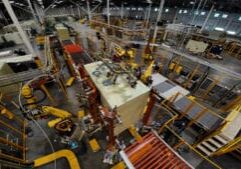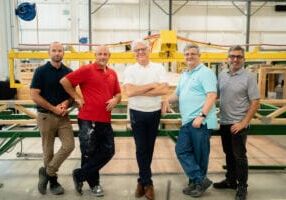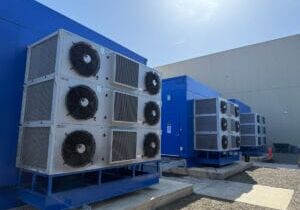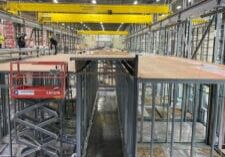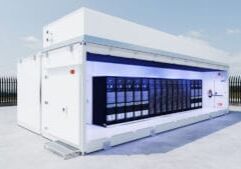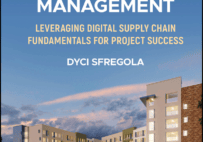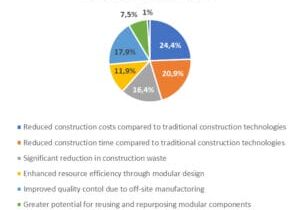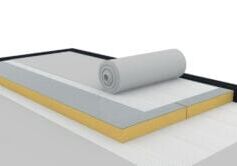Lean Construction – A Tool to Drive Productivity

Sneha Kumari, MBA, Six Sigma, is the manufacturing SME at New Gen Architects
As a Lean and Six Sigma Leader, I have highlighted below the importance of using Lean tools and inculcating the culture to address productivity issues facing modular construction.
According to a McKinsey report1, the construction sector overall accounts for a significant 13% of the global GDP. However, despite its substantial contribution, the sector’s annual productivity growth has only witnessed a meager 1% increase over the past two decades. This starkly contrasts with the 2.8% growth observed in the world economy and the 3.6% growth seen in the manufacturing sector. Additionally, modular construction2 could claim $130B of the U.S./Europe market by 2030, saving $22B annually and bridging a $1.6T productivity gap. Based on these findings, it becomes crucial for modular industries to prioritize operational efficiency to deliver maximum value to their customers.
While there are undoubtedly a multitude of causes contributing to this lag in productivity—both internal and external factors—there are specific internal factors that can be addressed to drive incremental improvements in efficiency and ultimately enhance productivity levels. In the face of labor shortages in the industry, enhancing productivity and efficiency with existing systems and processes becomes crucial. Lean methodologies offer valuable tools to achieve these goals.
Implementing a lean culture brings transformative impact by addressing operational challenges, reducing waste, and fostering continuous improvement. It emphasizes respect for people and delivers exceptional customer value. Lean breaks down silos, optimizes operations, and creates a proactive work environment.
Eliminating waste is a primary focus of lean methodology in construction, targeting defects, overproduction, waiting, non-utilized skills, transportation, inventory, motion, and over-processing. A range of tools can be utilized to tackle different types of waste in processes, effectively minimizing or eliminating their impact. This article highlights a few of these tools and the benefits of using them.3 But before we get into the tools that can be leveraged, it is important to note that you cannot improve what you cannot visualize. Exactly why it is important to map your current value stream.
Value Stream Mapping (VSM) is a team-based methodology that involves mapping out each step of the working process and identifying waste aka areas for improvement. VSM focuses on adding value and eliminating waste to achieve optimal outcomes. By visualizing the entire process and addressing non-value-added steps, teams can enhance efficiency and create a more streamlined workflow. This can be accomplished using simple colored sticky notes or any digital tool. However, for optimal engagement, it is highly recommended to conduct the exercise using sticky notes, ensuring active participation from the team during the initial mapping process. These mapping exercises can be eye-opening, revealing the significant amount of back-and-forth that teams go through before achieving a desired outcome. For example, traveling to different stations to get material and tools to finishing building the steel trusses because the materials are not close to the point of use.
Once you know the current state and the wastes highlighted in the process, you can start with one of the foundational tools of Lean which is 5S (Figure 1). The 5S methodology promotes workplace organization and efficiency by focusing on five key steps.
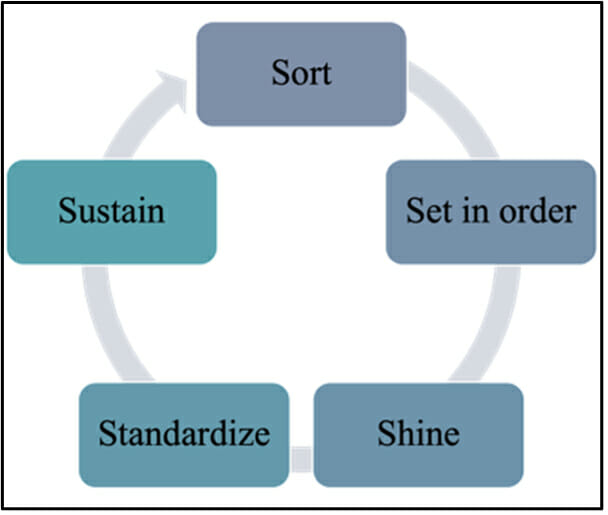
Figure 1. 5S Model.
- First, “Sort” involves determining what is necessary and removing anything that is not, reducing clutter and improving safety.
- Next, “Set in Order” establishes designated places for everything, streamlining workflow and reducing time wasted searching for materials.
- The third step, “Shine,” emphasizes consistently keeping the workspace clean and operational, preventing messes and equipment issues.
- “Standardize” involves creating standardized processes facilitating continuous improvement.
- Finally, “Sustain” emphasizes the importance of maintaining implemented processes.
Implementing the 5S methodology offers numerous benefits extending beyond the desire for a clean and organized work environment. It enhances safety by reducing hazards and the risk of accidents caused by cluttered workspaces. It improves the quality of outcomes by allowing individuals to focus on their work without distractions. Additionally, 5S enhances productivity as workers can easily locate materials and information, optimizing their time spent on value-adding tasks. Lastly, it contributes to better project scheduling through pull planning and consistent organization, ensuring materials are available when and where they are needed.
By embracing 5S principles, teams can achieve improved safety, quality, productivity, and adherence to project schedules. The investment of time and effort in creating an organized workspace pays off significantly in advancing towards project objectives.
Another valuable tool to visualize the team’s work and provide a quick overview of ongoing and completed tasks is a Kanban board (Figure 2). This is a project management system in Lean design and construction that enhances process efficiency through visualizing the workflow on a Kanban board.
This pull system aligns with Lean principles by starting work precisely where and when needed. By using the Kanban Board, teams can effectively visualize, plan, and set Work in Progress limits for different project stages. This exercise involves visualizing the workflow, setting Work In Progress limits, managing flow, conducting regular meetings, and collaboratively improving processes based on feedback.
The Kanban Board consists of sections like “To Do”, “In Progress”, and “Done”. These boards can exist in physical boards or even on digital tools as preferred by teams. By adhering to these practices, teams can optimize workflow, achieve continuous improvement, and deliver greater value to stakeholders.
While utilizing the Kanban board for work management, encountering complex problems that require in-depth analysis and critical problem-solving calls for another effective tool called A3 thinking. This exercise can be conducted on a simple sheet of paper or digitally, allowing for a deeper dive into the problem and facilitating a structured problem-solving approach.
A3 problem solving is a powerful Lean methodology that empowers teams to tackle problems collaboratively and make informed decisions. The essence of A3 thinking lies in laying the entire problem onto a single sheet of paper, allowing the team members to collaborate, analyze, and rationalize their problem-solving process. This approach not only enhances problem- solving process but also generates detailed written explanations that can be shared with senior management, fostering their confidence in the team’s capabilities. It guides the team through a systematic approach, leveraging the available tools and resources to arrive at the most effective countermeasure.

Figure 2. Kanban board
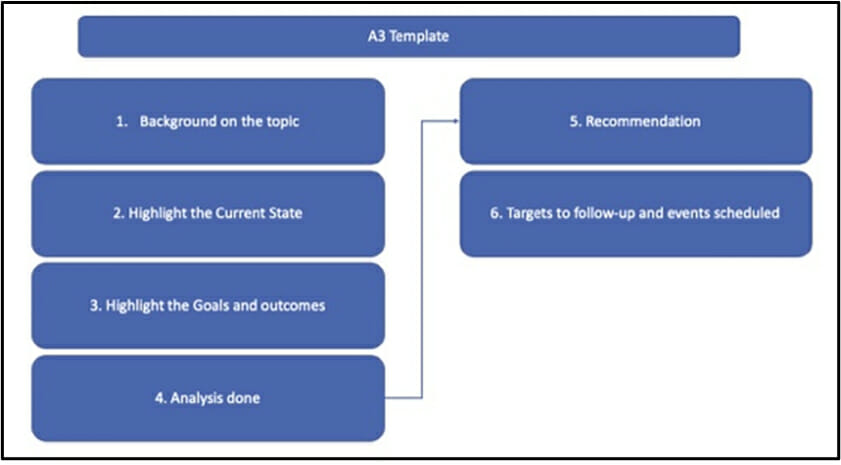
Figure 3. A3 template.
To ensure a thorough and well-rounded analysis, an A3 report (Figure 3) is typically filled out by a designated champion who gathers input and insights from team members. This collective knowledge and expertise contribute to a more holistic understanding of the problem and increase the likelihood of a satisfying outcome.
Before diving into the A3 process, it is crucial to accurately identify and define the problem at hand. In the context of design and construction, challenges such as unexpected lead times or communication breakdowns are common. By addressing key questions and clarifying the problem’s nature, teams can set the stage for successful A3 problem solving and navigate the path towards resolution.
It is important to note that Lean is a mindset and a culture that will need to be fostered over time and instilled with leadership leading it for others to follow. It is extremely important to manage and tread this change carefully. Organizations should identify and empower ambassadors or change agents who can champion this transformation. Respecting all employees and valuing their contributions is essential in creating a supportive culture. Investing in upskilling initiatives and providing opportunities for continuous learning demonstrates the recognition that people are the most valuable asset of a company.
By establishing mutual trust between management and employees, organizations can cultivate a collaborative atmosphere
that encourages innovation and growth.
More from Modular Advantage
Resia: Breaking All the Rules
Resia Manufacturing, a division of U.S.-based Resia, is now offering prefabricated bathroom and kitchen components to industry partners. Its hybrid fabrication facility produces more precise bathroom and kitchen components (modules) faster and at lower cost than traditional construction. Here’s how Resia Manufacturing does it.
How LINQ Modular Innovates to Bring Modular To The Market in the UAE and Beyond
LINQ Modular, with an office and three manufacturing facilities in Dubai, is a modular firm based in United Arab Emirates. The company is on a mission: to break open the housing and construction markets in the Gulf Cooperation Council (GCC) area with modular.
ModMax: Redefining Modular Construction with Confidence and Precision
ModMax was born out of frustration—frustration with five persistent pain points in modular construction: Permitting bottlenecks. Production delays. Rigid designs. Disconnect between “the office” and the field. Lack of transparency and communication.
LifeArk: Disaster-Resilient Housing from Recycled Plastic and 100-year-old Technology
Wee compares LifeArk’s housing units to Yeti coolers, as they are built similarly. Each component takes 15 to 20 minutes to manufacture, has an R-value of 40, and includes molded slots and chases for wiring, plumbing, fire sprinklers, and other utilities.
Building the Future of Modular Edge Infrastructure
The edge data center market is expanding rapidly, driven by the surge in AI workloads, IoT adoption, and the need for localized compute power. In these environments, sustainability, scalability, and reliability are non-negotiable. Cooling is among the most complex challenges for operators—and one of the most decisive factors in long-term success.
Accelerating Light-Gauge Steel Construction: A Semi-Automated Digital Workflow for Off-Site Projects
For construction professionals, the message is clear. By adopting semi-automation and digitalization, companies can deliver projects faster, more accurately, and more profitably, while also building stronger collaboration across teams. The approach is not about replacing people with machines, but about empowering people with better tools and processes.
Why Modular Data Centers Are Gaining Momentum
Artificial intelligence, high-performance computing, and edge applications push the limits of traditional “stick-built” data centers. They take years build, often struggle with high density workloads, and aren’t optimized for deployments near end users. Modular data center platforms are purpose-built to address these challenges, offering flexibility and scalability to adapt to evolving technologies, while opening new opportunities for the modular construction industry.
Supply Chain Innovation in Action: 5 Habits Every Modular Leader Should Practice
By applying these principles to supply chain practices — collaborative planning, strategic procurement, scenario modeling, digital tools, and transparent forecasting — construction leaders can build value chains that are not just efficient and agile, but truly innovative.
Exploring the Role of Modular Integrated Construction (MiC) in Advancing Circular City Principles – A Survey of Stakeholder Perspectives
The survey findings highlight the significant potential of Modular integrated Construction (MiC) in advancing the development of circular cities. By reducing costs, accelerating construction timelines, and minimizing waste generation, MiC offers a promising approach to sustainable urban development.
The Use of MS POLYMER™-Based Sealants and Adhesives in Modular Building
These products combine flexibility and elastic recovery with excellent adhesion to different substrates and have already shown their usefulness in traditional construction. Now it’s time for them to be put to use in the modular construction industry.

